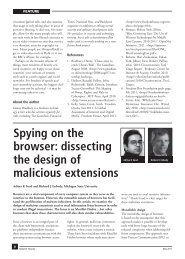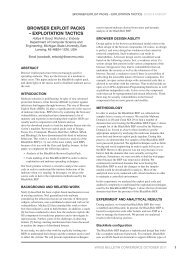Sweet Orange Exploit Pack Design Analysis - SecNiche Security Labs
Sweet Orange Exploit Pack Design Analysis - SecNiche Security Labs
Sweet Orange Exploit Pack Design Analysis - SecNiche Security Labs
You also want an ePaper? Increase the reach of your titles
YUMPU automatically turns print PDFs into web optimized ePapers that Google loves.
VIRUS BULLETIN www.virusbtn.com<br />
exploitation process faster. This is done to achieve high<br />
performance and optimization.<br />
PROPACK<br />
Figure 4: Traffic limit in SO.<br />
Figure 4 shows that the maximum traffic limit implemented<br />
in SO is 150,000 unique hits.<br />
Advancements in performance<br />
During our analysis, we have noticed a few improvements<br />
in SO’s request processing mechanism to make the<br />
Batch mode execution<br />
The Pro<strong>Pack</strong> BEP implements a buffer-based technique<br />
to manage incoming connections. The buffer holds<br />
information about the victim’s machine including what<br />
plug-ins are present, the OS version, IP address, etc. When<br />
connection attempts are received from target machines,<br />
the exploit-serving component initiates a buffer which<br />
is used to queue the requests. In other words, Pro<strong>Pack</strong><br />
executes batch processing in which all the connection<br />
attempts are treated as jobs that are required to be<br />
completed without manual intervention. This means that<br />
all the specific data is selected earlier and pushed into the<br />
exploit-serving component depending on the information<br />
extracted from the user’s machine. In addition to this, the<br />
threading is done efficiently. With proper threading and<br />
batch processing, multiple requests can be served at the<br />
same time and every thread is shipped with a different<br />
executable that is obfuscated differently. This approach<br />
also helps to deploy server-side polymorphism, in which<br />
alert tcp $HOME_NET 1024: -> $EXTERNAL_NET $HTTP_PORTS (msg:”Propack <strong>Exploit</strong> Detection”; fl ow:established,from_<br />
client;<br />
fl owbits:set,Propack;<br />
fl owbits:noalert;<br />
content:”GET”;<br />
http_method;<br />
content:”.php?j=1”;<br />
http_uri;<br />
content:”|26|k=”;<br />
within:3;<br />
content:” HTTP/1.1|0d 0a|”;<br />
within:15;<br />
content:!”|0d 0a|Cookie|3a| “;<br />
http_header;<br />
pcre:”/\.php\?j=1&k=[12345]/U”;<br />
reference:url,[ ]; classtype:<strong>Exploit</strong>; sid:XXXXXXXXX; rev:1; )<br />
alert tcp $EXTERNAL_NET $HTTP_PORTS -> $HOME_NET 1024: (msg:”Propack Malware Binary Successfully Loaded “;<br />
fl ow:established,from_server;<br />
fl owbits:isset,Propack;<br />
content:”Content-Disposition: attachment|3b| fi lename=”;<br />
offset:50;<br />
depth:400;<br />
content:”MZ”;<br />
distance:0;<br />
content: “PE|00 00|”;<br />
within:250;<br />
reference:url,[ ]; classtype:<strong>Exploit</strong>; sid:XXXXXXXXX; rev:1; )<br />
Listing 1: Pro<strong>Pack</strong> detection signatures.<br />
MARCH 2013<br />
13












